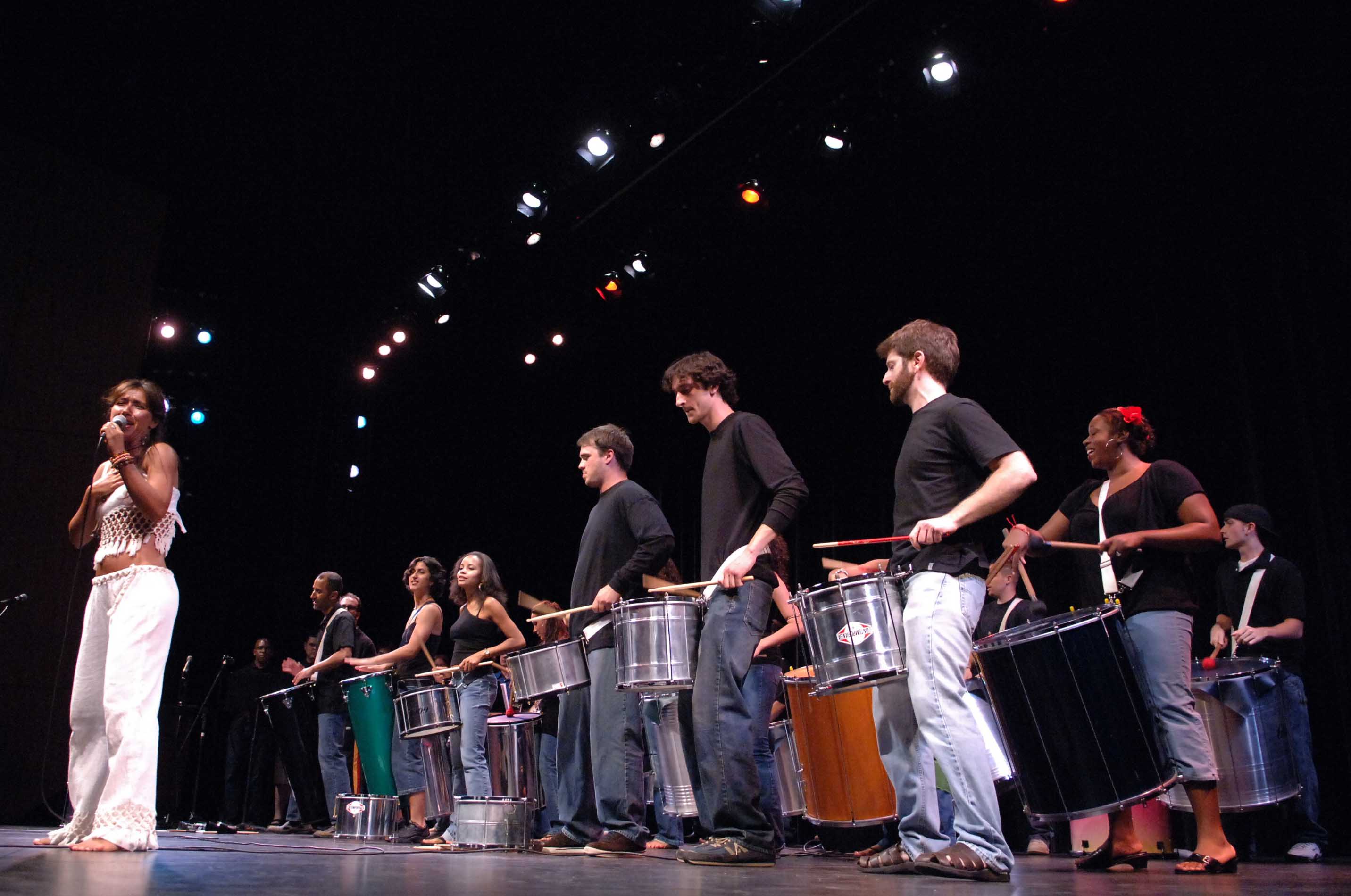It’s Hammer time for UCLA ensembles

The UCLA Brazilian Ensemble performs in 2006. They play sacred music, brought to South America by African slaves. Musicians were persecuted by the Brazilian government and church for communicating polytheistic values.
By Brittany Taylor
May 6, 2010 9:20 p.m.
Sounds of atabaque and surdo drums playing sacred music that tells the tales of African slaves and traditional Bulgarian a cappella folk songs accompanied by contemporary instruments will be coming from UCLA. The UCLA Brazilian Ensemble and Balkans Ensemble will be presenting these traditions when they perform at the Hammer Museum on Saturday. With the help of their directors Kirk Brundage, Ivan Varimezov and Tzvetanka Varimezova, the performers of both ensembles will share their talents at the Spring Festival of World Music and Jazz.
These ensembles are part of the Department of Ethnomusicology in the UCLA Herb Alpert School of Music and have been rehearsing for their performance at the Hammer.
“Both the Music of Brazil Ensemble and the Music of the Balkans Ensemble got their start at UCLA in 2000. Both groups performed in the first Spring Festival of World Music Concert at the Hammer in 2004,” said Kathleen Hood, publications director and events coordinator of the ethnomusicology department.
According to Hood, the ethnomusicology department started to work with the Hammer in order to involve the festival with the UCLA community and give the ensembles an opportunity to perform in a setting outside the campus.
The Brazilian ensemble music contains an array of drums, singing and dancing. Brundage and the Brazilian ensemble will be performing both sacred and carnival music from Brazil.
The drums that members of the ensemble will play are called atabaque, surdo, repique and snare drum. The timbau drum is the biggest drum and will be played by Brundage. Each drum helps in either the sacred or carnival music.
Sacred music, also known as candomble, was brought to Brazil by African slaves. Each song, rhythm and dance tells a different story.
Brundage explained that the musicians who played the sacred music he teaches his students were persecuted by the government and the church in Brazil. Artists were persecuted due to the polytheistic values of the candomble music. As a result, this music is not heard often.
“Part of the reason that we (play the sacred music) is to bring it out of the shadow,” Brundage said.
Carnival music is more well-known and can be found throughout Brazil. Brundage wants to expose people to the Brazilian culture and allow them to learn things they would otherwise probably never learn.
“It’s a window on another culture that they probably don’t have direct experience with, and because of that exposure, they probably get a deeper and more accurate picture of what that culture is,” Brundage said.
Through the music, Brundage’s students learn about sounds that are not commonly heard outside of Brazil. For most people, when they think about Brazilian music, they think of “The Girl From Ipanema” or a carnival festival with women dancing in the streets wearing flamboyant feather-filled outfits.
“There was music before “˜The Girl From Ipanema’ and after “˜The Girl From Ipanema,'” Brundage said.
One can expect a cultural experience from the Brazilian ensemble’s performance at the Hammer. They will be performing the sacred and carnival music they have been focusing on throughout the school year.
“People will get an exciting glimpse into the old and the new,” Brundage said.
Not only has the Brazilian ensemble been blending old and new culture together, but the Balkans ensemble has also been experimenting. The Balkans ensemble directors, Ivan Varimezov and Tzvetanka Varimezova, have been teaching their students about Bulgarian culture and music.
“We’ve been teaching for nine years at UCLA. We are teaching Bulgarian music the traditional way and the contemporary,” Varimezova said.
During those nine years, they have exposed numerous students to Bulgarian folk music and even inspired some students to return to sing in the ensemble.
“It’s really interesting. They graduate but they come back to play and sing with us,” Varimezova said.
Both co-directors have taught their students traditional a cappella Bulgarian folk songs and added modern instruments to complement the music. Both Ivan and Tzvetanka have been teaching their students to play Balkan music with flutes, pianos, guitars and saxophones, and to sing with the proper vocal techniques of the Balkan music.
“Our name is the Balkans ensemble because our music is for the Balkans, from the Balkans. Our sound is so open, and we are trying to address our sound to everyone,” Varimezova said.
The ensemble is composed of 30 female singers and 10 musicians.
“Our classes are open for anybody. … When we play our music, everything is open, and we can improvise,” Varimezova said.
For their performance at the Hammer, they will be presenting classic Bulgarian folk songs with untraditional instruments.
“The band my husband conducts is like a wedding band. Wedding style (music) is freedom playing. People have a lot of joy when we play and sing our music. Usually they dance with our playing and singing. It is fun to see people enjoy our music,” Varimezova said.
These ensembles will collaborate with the Hammer once again to educate and captivate audiences.
“(The Brazilian and Balkans ensembles) were fantastic, energetic and professional, and very crowd-pleasing,” said Susan Yank, Hammer assistant director of academic programs.
These ensembles will entertain and expose their audience to different cultures this Saturday.
“Be prepared to learn in the moment,” Brundage said.


